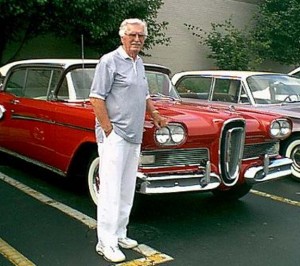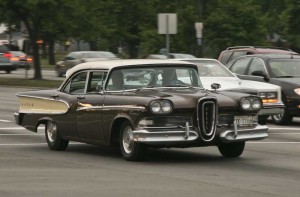
Roy Brown with one of his Edsels at a 2001 collector's meet. Image courtesy EdselNet, one of many sites dedicated to the once-maligned machine.
It became a symbol of failure, the name long remembered even by those who didn’t remember the car itself. But not to Ray Brown Jr., the man who designed the disastrous Edsel and continued championing it until his death at 96.
Brown was already a veteran designer at Ford when he was assigned to lead the team charged with coming up with an all-new sedan that would slot in-between the maker’s main “Blue Oval” brand and the more upscale Lincoln. But what hit the streets in 1957 fell far short of general expectations and, after losing what would today work out to billions of dollars, Ford quickly pulled the plug on the Edsel – and sent Brown into temporary exile overseas.
“I’m proud of the car,” he said in an interview with Florida’s Sun-Sentinel newspaper in a 1985 interview, insisting that, “There is not a bad line on the car.”
Indeed, the Edsel received significant praise during early previews, a New York Times obituary of Brown acknowledging the paper had called the car “radically different,’ and described the styling as “spectacular.”
What hit the street was not precisely what Brown had penned. The production car did maintain the distinctive horizontal headlamp and taillight design. And it featured a more elegant and streamlined look than some of the other products to hit the road in 1957. But the graceful new grille that was on the original prototype had been revised by committee, as one Ford old-timer once explained, in order to deliver more air to the engine. And the result was a signature design theme still derided as the “horse collar.”
That generated plenty of criticism, both playful and crude, including one editorial cartoon comparing the design to an Oldsmobile sucking a lemon. Others likened the grille to a toilet seat. “There are people that have toilet-seat minds,” Brown said in his interview with the Sun Sentinel. The brand itself came to be known as “Ford’s Folly,” and even the “E-Bomb.”
It wasn’t the reaction Ford had in mind. The maker had big expectations and launched a massive marketing campaign leading up to its introduction, even asking for suggestions for the car’s name from well-known writers. It rejected some particularly quirky ones from poet Marianne Moore, who suggested both the Intelligent Whale and Utopian Turtletop.
The Edsel introduced a variety of new and more upscale features, including the “Teletouch” bush-button shifter – something that is just making its return on cars like the Lincoln MKZ and the revived Dodge Dart – and a “rolling dome” speedometer.
But it didn’t come cheap, at anywhere from $2,400 to $3,800, at a time when some mainstream sedans were offered for two-thirds the price. And the Edsel didn’t quite have an easy fit in the Ford line-up, the new brand butting up against the mid-range Mercury that was then extremely popular.
“This car was kind of aimed at a market that didn’t really exist,” said Matt Anderson, the curator of transportation at the Henry Ford, a museum near Ford Motor Co.’s suburban Detroit headquarters, told the Times in its obituary.
It didn’t help, either, that the Edsel was sent up against extraordinarily tough competition, notably from the now-legendary ’57 Chevrolet.
Critics looked for a range of reasons to explain why the Edsel failed. They even blamed the addition of new safety gear, such as self-adjusting brakes and the first childproof rear door locks, as well the industry-first standard-equipment seatbelts — which triggered the long and erroneous belief in industry circles that “safety doesn’t sell.”
Then there was the name itself, which didn’t evoke exciting holiday destinations or powerful animals, like so many other Detroit cars of that era. The Edsel was named for the only son of company founder Henry Ford. He had served as the automaker’s president before dying young and unexpectedly in 1943.
But whatever the reason, fail the Edsel did. Total sales came to barely 100,000 over the next two years, about half of the initial expectations. Ford struggled to save the new brand, in 1958 merging its free-standing dealer network in with Lincoln and Mercury.
But by then, the name had already become synonymous with failure and the Edsel was pulled from production in 1959. A small number of cars were built with the 1960 model-year designation, and less than 3,000 were sold.
Ironically, one model intended to join the Edsel line-up in 1953 was hastily rebranded, Ford not wanting to waste the money it spent to design and tool up for the car. Badged the Ford Comet, it became one of the hits of the 1960 model-year.
Decades later, those estimated 10,000 Edsels that survive are considered highly collectible, the Edsel Owners Club of America claiming thousands of members. The Edsel Pages, a website for collectors, suggests a high-quality 1958 Edsel Citation can go for as much as $55,000, and one of the few 1960 Edsel Rangers might command $63,000.
When fans would mention such matters to him years later, Brown would reportedly respond, “Where were you in 1958?”
A number of its features, especially on the safety side, were eventually adopted by other manufacturers.
Born in Hamilton Ontario on October 30, 1916, Roy Abbot Brown would survive the Edsel debacle. He was reassigned to Great Britain, Ford’s European headquarters, and reestablished his credentials with the design of the hugely popular Ford Cortina. He eventually was brought back to the States and remained with Ford until 1974.
Brown died in Michigan on February 24 at the age of 96.

